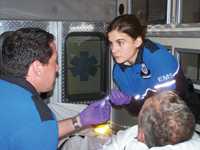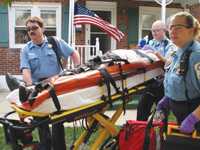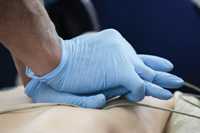CARES Strengthens Links in Chain of Survival

Dispatcher-assisted CPR is a key link in the chain of survival.
Almost everyone knows someone who has been affected by unexpected cardiac arrest. In fact, out-of-hospital cardiac arrest (OHCA) ranks among the top three types of cardiac disease that claim lives annually. Unfortunately, only seven percent of the 300,000 people who experience OHCA in the U.S. each year survive — that's a staggering 279,000-plus deaths. Despite the fact that almost two-thirds of these cases are treated by emergency medical services (EMS) providers, community rates of OHCA survival are generally low. So what is the key to increasing the odds of survival for individuals who experience OHCA? The key is quickly and effectively implementing "chain of survival". The five links in the chain of survival are: 1) Immediate recognition of cardiac arrest and activation of the emergency response system; 2) Early cardiopulmonary resuscitation (CPR) with an emphasis on chest compressions; 3) Rapid defibrillation; 4) Effective advanced life support; and 5) Integrated post-cardiac arrest care. However, many communities can't measure how effectively the chain is activated without adequate performance measures, thus losing opportunities to improve emergency cardiac care and save lives.
In 2004, the Centers for Disease Control and Prevention began collaboration with Emory University and the American Heart Association to take a closer look at whether all the links in the chain were working properly, by developing the Cardiac Arrest Registry to Enhance Survival (CARES). CARES, is a secure, quality assurance program designed to increase OHCA survival rates by collecting data to help communities identify areas in the EMS system that need attention, and implement improvements based on the results. The registry, which CDC piloted in the Atlanta area in 2005, has expanded to 40 participating communities in 25 states, as well as nine state based registries (Arizona, Delaware, Hawaii, Illinois, Minnesota, North Carolina, Minnesota, Utah and Washington). CARES, which is managed by Emory University, has been a critical first step in reducing the overall OHCA death toll. The program fully transitioned to the private sector in 2012. Partners who support CARES include the American Red Cross, Medtronic Foundation, American Heart Association, and Zoll Corporation and the Woodruff Health Science Center at Emory University.

Each year, 300,000 cases of out-of-hospital cardiac arrest (OHCA) occur in the United States. Almost two-thirds are treated by emergency medical services (EMS) providers.
CARES' mission is to save more lives from OHCA by strengthening collaboration among 9-1-1 centers, EMS agencies and hospitals, providing a simple, confidential, HIPAA-compliant process to determine patient outcomes and providing technical assistance to help community leaders identify and prioritize opportunities to improve EMS performance. The program is designed to help communities identify these improvement opportunities by providing an up-close look at who is affected, where and when cardiac events are occurring, what is or is not working well and most importantly how improvements can be implemented. Participating sites collect data from three primary sources of cardiac care: 911 dispatch centers, EMS provides and receiving hospitals.
The first moments after cardiac arrest are crucial. In fact, chances of survival decrease 5 -10 percent every minute without CPR. Highly effective, well trained 9-1-1 dispatchers are a crucial link in the chain of survival. That means EMS dispatchers who can quickly take control of the call, assess the situation, and engage the caller in life-saving actions. According to American Heart Association the recommendation is for dispatchers to initiate bystander CPR within one minute during potential cardiac arrest calls.
This link is critical because even if the dispatcher has the appropriate information and is ready to provide instructions, there must be someone on- scene willing to carry out those instructions and perform bystander CPR. Unfortunately, many bystanders are hesitant, and even unwilling to perform CPR because of panic, fear, complexity of CPR, unwillingness to do mouth-to-mouth resuscitation, and cultural barriers to name a few. When properly trained, dispatchers can quickly calm panic-stricken callers, help them identify cardiac arrest, and give them confidence to perform CPR using chest compressions only; assuring them that they won't hurt the patient.

The first moments after cardiac arrest are crucial. Chances of survival decrease 5-10 percent for every minute without CPR.
"CARES allows participating communities to view their own statistics online confidentially and compare it to other data collected at the local, regional or national level," said Bryan McNally, MD, MPH, Executive Director of CARES. Many communities are already using dispatch-assisted CPR programs, and seeing positive results. For example the Arizona Save Hearts in Arizona Registry and Education (SHARE) Program) developed a formal, dispatch-assisted CPR program for their 9-1-1 centers. The model was based on three essential components: protocol development, dispatcher training and quality assurance systems to monitor performance. As a result of the program the Mesa, Arizona community saw improvements they believe are statistically significant that include a 28 percent reduction in the average time it took for dispatchers to begin CPR instructions, as well as a 37 percent reduction in the start time of telephone assisted first compression. "CARES is one of the few programs that has the ability to show the impact of bystander CPR. We believe a combined approach of community based CPR training and a greater emphasis on dispatcher instruction will help to improve survival outcomes nationally," he said.
"CDC's strong support for CARES has been key to its broad adoption by communities nationwide," said McNally. "The future of CARES and improved OHCA will depend on an equally strong private-public partnership to ensure this program's growth and long-term sustainability. We envision that CARES will be adopted one community, one state at a time, with the goal of improving OHCA locally and globally."
- Page last reviewed: March 19, 2014
- Page last updated: March 19, 2014
- Content source:


 ShareCompartir
ShareCompartir